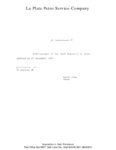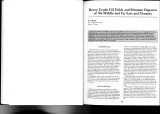TO
1 - 25 of 20
| Title | Date | Subject | Description | ||
|---|---|---|---|---|---|
| 1 |
 |
1987-88 General Catalog | 1987 | University of Utah catalogue; (Catalog) | Bulletin of the University of Utah, General Catalog 1987-88 |
| 2 |
 |
A heavy-oil case study on a single well in Venezuela, MFM-7s, using cores and logs | 1987 | heavy-oil case study; Venezuela well; MFM-7s; well cores; well logs; heavy-oil reservoirs | Planning for optimum production from heavy-oil reservoirs requires a deep understanding of their geological and petrophysical characteristics, synthesized from intermittent core and continuous log data. In this paper the study developed for the MFM-7S well, operated by S. A. Meneven in the Faja Petr... |
| 3 |
 |
A report to Idaho National Engineering Laboratory | 1987 | Three Texas lignites (Jewett, Big Brown, and Bastrap), weathered and fresh tar sand, weathered and fresh Gilsonite and weathered oil shale have been studied using Py-MS (pyrolysis mass spectrometry) and further analyzed using the SIGMA program. | |
| 4 |
 |
A solvent extraction process for tar sand | 1987 | Sunnyside, Utah; Tar sand; Solvent extraction; Bitumen; East central Utah; Ore; Hydrocyclones; Pentane-deasphaltening; Rotary kiln steam strippers; Oil | A process has been investigated for solvent extraction of bitumen from Sunnyside, Utah, tar sands. The Sunnyside deposit, in east central Utah, has 1 to 2 billion barrels of geological reserves with a richness of 6 to 10 wt% bitumen. In this process, the ore is crushed and the bitumen is dissolved f... |
| 5 |
 |
Bibliography of tar sand deposits in Utah | 1987 | ||
| 6 |
 |
Bitumen deposits of northwest Alabama | 1987 | bitumen deposits; northwest Alabama deposits; bituminous rocks | Bituminous rocks of Mississippian age crop out in northwest Alabama within a 113-km (70-mi) long belt. Bitumen deposits have been confirmed by coreholes to be present in the subsurface for a distance of at least 16-24 km (10-15 mi) south of the outcrop. Geochemical analyses indicate the bitumen to b... |
| 7 |
 |
California plio-miocene oils: Evidence of early generation | 1987 | plio-miocene oils; California oil; source rocks; commercial generation; LOM; hydrocarbon concentration; oil quality | Early generation of oil from Monterey and equivalent source rocks may well be the primary controlling factor on oil quality in the coastal basins of California. Commercial generation has occurred at reflectance levels as low as 0.3% R0. The wide range of chemical characteristics of these oils is com... |
| 8 |
 |
Classification of natural bitumen: A physical and chemical approach | 1987 | natural bitumen; Classification of bitumen; physical properties of natural bitumen; chemical properties of natural bitumen; crude oil; natural bitumen; tar sands oil; bitumen | By correlation of various selected physical and chemical properties of heavy crude oils and natural bitumens, an attempt is made to solve classification problems. The criteria used here are, in descending order: viscosity, gravity, H/C atomic ratio, O/C atomic ratio, optical reflectivity; volatiles,... |
| 9 |
 |
Common conditions for heavy oils | 1987 | Heavy oils; Colloidal admixtures; Hydrocarbons; Asphaltenes; Trace metals; Organic residues; Alberta basin; Eastern Venezuela basin; Athabasca; Orinoco; Heavy-oil depositys; Common conditions for heavy oils | Field evidence suggests that conditions for the collection and retention of various hydrocarbons exert control over the composition of resident hydrocarbon mixtures. Heavy-oil deposits demonstrate that control very clearly. Heavy oils are essentially colloidal admixtures of hydrocarbons, usually acc... |
| 10 |
 |
Delineation of gas sands by seismic stratigraphy in the Pericocal area, Orinoco Heavy Oil Belt, Venezuela | 1987 | gas sands; seismic stratigraphy; Pericocal area; Orinoco Heavy Oil Belt; deliniation of gas sands; gas sand bodies | The purpose of this study is to define the extent of gas sand bodies found in the Oficina Formation by well SDZ-79X, in the Pericocal area of the Orinoco Heavy Oil Belt. True amplitude processing was applied to 30 km (19 mi) of seismic survey lines in the vicinity of this well. The processing showed... |
| 11 |
 |
Diluent-assisted hot-water processing of tar sands | 1987 | hot water processing; tar sands; diluent-assisted hot-water processing; bitumen viscosity | The influence of diluent addition and temperature on bitumen viscosity of tar sands from nine locations in the U.S.A. and Canada has been investigated. Subsequently, hot-water bitumen-recovery experiments were carried out at temperatures from 33°C to 95°C. Kerosene was added as needed to maintain ... |
| 12 |
 |
Geological assessment of heavy-oil reservoirs in the Lloydminster area, using a computerized data base | 1987 | heavy-oil reservoirs; geological assessment; heavy-oil reservoirs; wells | Heavy-oil reservoirs of the Lower Cretaceous Mannville Group in the Lloydminster area (Western Canada) occur in a sequence of complexly arranged sandstones, siltstones, shales, and coals. Trapping mechanisms vary, and the precise geological controls governing hydrocarbon accumulations are not well u... |
| 13 |
 |
Geology and genesis of the coast range province of California and its hydrocarbon deposits | 1987 | hydrocarbon deposits; tar sand; oil shale | California is along the western borderland of North America where sedimentary deposits accumulated along the eastern Pacific margin. During that time, subduction diastrophism prevailed in the late Mesozoic-early Cenozoic era, and right-lateral strike-slip shear diastrophism prevailed in the middle a... |
| 14 |
 |
Geology of heavy crude oil and natural bitumen in the USSR, Mongolia, and China | 1987 | geology; heavy crude oil; natural bitumen; USSR, Mongolia, China; heavy oil resources; natural bitumen resources | The USSR, Mongolia, and China occupy an area of 33,385,390 km2, or a quarter of the earth's land area. Large reserves and resources of heavy crude oil and natural bitumen are present, especially on the Eastern European (Russian) and Siberian platforms, where at least 700 billion bbl is present (out ... |
| 15 |
 |
Heavy crude oil fields and bitumen deposits of the Middle and Far East and Oceania | 1987 | heavy crude oil fields; bitumen deposits; Middle and Far East and Oceania; oil resource | A total of 119 heavy-oil fields are located in the Middle and Far East and Oceania, in 19 countries. Of these, 12 have ultimate recoveries of more than 500 million barrels, and nine of more than 1000 million barrels. About 97% of the total resource of 120,000 million barrels is found in the Middle E... |
| 16 |
 |
Heavy oil production operations in Potiguar Basin, Brazil | 1987 | heavy oil production operations; heavy oil; Portiguar Basin; oil fields; oil | The Potiguar basin is located on the northeastern Brazilian coast and comprises an onshore portion with 21,500 km2 (8300 mi2) and its offshore extension (Fig. 1). In the last 4 years, many oil fields have been discovered in the onshore portion, where today's production reaches 20,000 bbl/d. The oil ... |
| 17 |
 |
Heavy-oil and bitumen projects in Madagascar | 1987 | heavy oil; bitumen; Madagascar; Bemolanga tar sand; Tsimiroro heavy crude oil; mining and bitumen-separation operation | Madagascar contains two important deposits, the Bemolanga tar sand and the Tsimiroro heavy crude oil. Although known for years, they have received intensive investigation recently in effort to achieve a measure of energy independence in the face of rising oil costs and dollar-exchange values. The ai... |
| 18 |
 |
Heavy-oil deposit, Great Salt Lake, Utah | 1987 | heavy-oil deposit; Great Salt Lake; Neogene basins | The western portion of the Great Salt Lake contains two large Neogene basins, informally called the "North" and "South" basins. These basins are separated by an arch that trends northeast between Carrington Island and Fremont Island. Both basins are filled with Miocene, Pliocene, and Quaternary sedi... |
| 19 |
 |
Influence of biodegradation on the chemical composition of heavy oil and bitumen | 1987 | biodegredation; chemical composition of heavy oil and bitumen; heavy oil; bitumen; biodegredation of petroleum | Biodegradation of petroleum is a selective metabolism of special organic compounds by an ensemble of microorganisms. It apparently starts under aerobic conditions, which are provided in areas invaded by surfacederived, oxygen-rich formation waters. Bacteria introduced into an oil pool with meteoric ... |
| 20 |
 |
Light-oils transformation to heavy oils and asphalts-assessment of the amounts of hydrocarbons removed and the hydrological-geological control of the process | 1987 | light-oils; heavy oils; asphalts; assessment; hydrocarbons; petroleum resources; oil alteration | Heavy oils frequently represent a residue left after removal of saturated and aromatic hydrocarbons by various alteration processes. They are characterized by a high content of asphaltenes and polar compounds and by higher sulfur content than the light oils from which they were derived. In the Dead ... |
1 - 25 of 20
